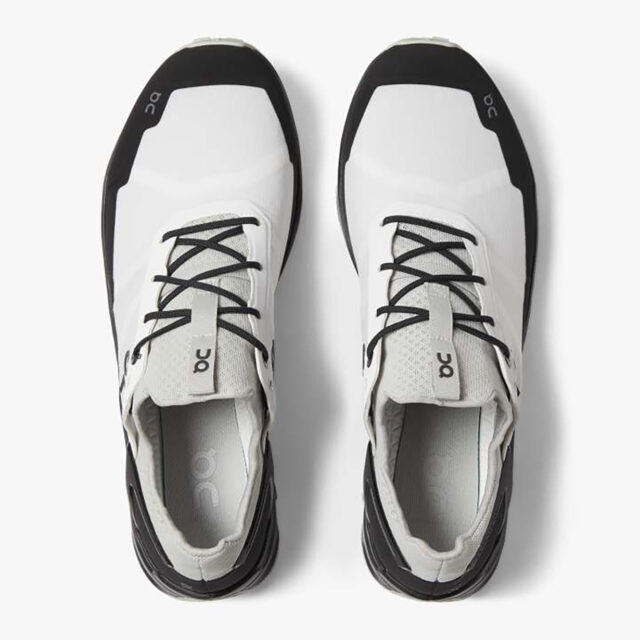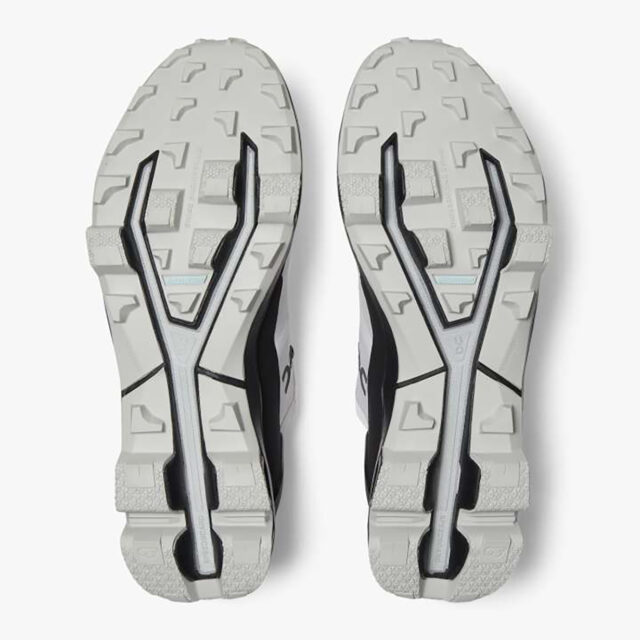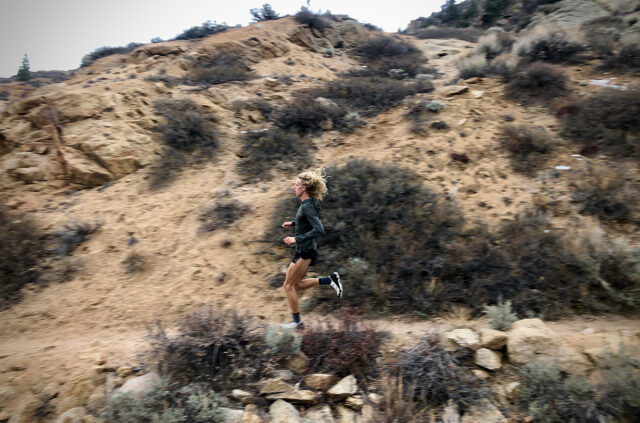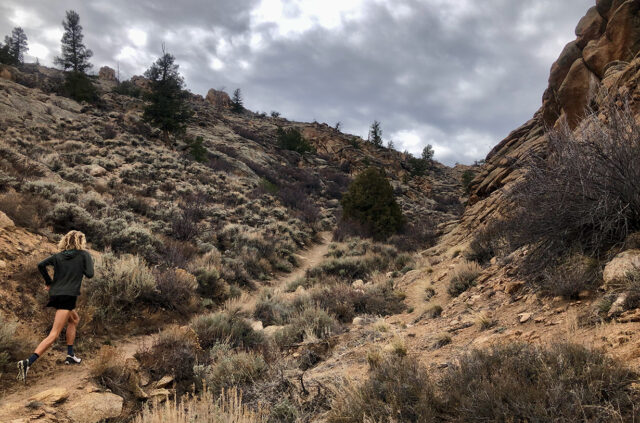ON Cloudventure Peak
Test Locations: Gunnison–Crested Butte, Colorado
Test Duration: 150 miles
Stated Stack Height: 24 mm (Heel) / 20 mm (Forefoot)
Stated Heel-to-Toe Drop: 4 mm
Stated Features:
- Missiongrip™ Rubber outsole
- New aggressive outsole pattern
- Breathable ripstop upper
- New Speedboard™ for snappier ride
MSRP: $149.99
Size Tested: US Men’s 11
Stated Weight: 260 g / 9.17 oz
Blister’s Measured Weight (US Men’s 11): 288 g / 10.1 oz
Reviewer (See Runner Profile): 6’1” 143 lbs

Intro
The world of lightweight trail racing shoes is a competitive one — almost every brand has at least one trail shoe that’s designed to be light, fast, and ready for race day. These lightweight shoes try to strike a balance between traction, comfort, and speed. While iconic shoes like those in Salmon’s S/Lab Sense series have dominated the market for many years, there is a new contender. Sleek, stylish, and Swiss, ON running burst onto the trail running scene only a few short years ago. In that time they have managed to collect quite the following, both in the trail shoe market as a whole and in the trail racing category in particular.
Now on its second iteration, the Cloudventure Peak is ON’s most recent take on a fast trail racer. Featuring an entirely revamped outsole, midsole, and upper, it is certainly a huge improvement over the first version of the shoe — a shoe that I still thoroughly enjoyed running in. But how does the Cloudventure Peak stack up against other well-established models in the trail racing space? In this review, I’ll attempt to dig into where the Cloudventure Peak performs well, what I like about the shoe, and where I feel ON could make some improvements.
ON Cloudventure Peak: New vs. Old
I ran a couple hundred miles between two pairs of the original Cloudventure Peak. I enjoyed the shoe’s combination of flexibility, light weight, and a surprisingly soft ride. With that said, I never felt like I could trust its CloudTec outsole on anything other than a packed-down, non-technical trail. The outsole of the first version also contributed to a fairly short lifespan for the shoe (more on that later). The new version of the Cloudventure Peak is a practical evolution of the previous version.
Featuring a more aggressive outsole with true lugs, a new tongueless upper, and a more accommodating forefoot fit, the updated Cloudventure Peak is a great revision to an already promising platform. Overall, it is a very similar shoe to the previous version with some solid upgrades 一 if you liked the previous version of the Cloudventure Peak you will probably find yourself right at home in this version. If you are new to the world of ON trail shoes, the new Cloudventure Peak certainly holds an appeal to a broader audience.
Fit
As I mentioned above, I have run in previous versions of the Cloudventure Peak, and the fit of this second iteration is certainly, in my opinion, improved. As with all shoes, we recommend that you try them on first, if at all possible, just to get a sense of how the shoe fits your particular foot shape. For reference, I have a fairly narrow foot with a high arch. I generally prefer shoes that snugly lock down through the midfoot without squeezing my toes together in the forefoot.

With that in mind, the Cloudventure Peak has a very comfortable fit for my preferences and my particular feet. Its tongueless upper wraps around my foot quite nicely, and I’ve had no issues with heel slippage. On flatter terrain, the Cloudventure Peak fits very securely to my foot while still providing plenty of room for my toes to splay. While it’s not as wide as the Altra Superior 4.0, I found the Cloudventure Peak’s toe box to be a bit roomier than the Salomon S/Lab Sense 8 and Sense 4 /Pro, and fairly comparable to the Hoka Torrent 2.
I have found that, while running down steeper trails, my foot does tend to slide to the front of the Cloudventure Peak. This did cause some issues for me on longer descents, where I’d find my toes right up against the end of the shoe. I tried a heel-lock lacing pattern using the second set of eyelets, and that did seem to eliminate most of the problem. Aside from that, the overall fit of the Cloudventure Peak has been very comfortable and felt reasonably secure on all but the steepest of downhill terrain.
Weight (and Comparisons)
With a stated weight of 260 g / 9.2 oz in a men’s size 9, the Cloudventure Peak comes in at a fairly standard weight for a shoe in the lower-stack-height category. It is by no means the lightest shoe in its class, but it isn’t overly heavy, either. For reference, here’s a list of comparable options and their stated weights (all weights are based on a US Men’s size 9):
195 g / 6.8 oz — Salomon S/Lab Sense 8
204.2 g / 7.2 oz 一 Hoka One One Evo Jawz
210 g / 7.5 oz — Inov-8 X-Talon 210 G
255 g / 8.9 oz — Salomon Sense 4 /Pro
260 g / 9.2 oz — ON Cloudventure Peak
260 g / 9.2 oz — La Sportiva Kaptiva
263.4 g / 9.3 oz — Hoka One One Torrent 2
280.6 g / 9.9 oz 一 Topo Athletic Mtn Racer
On trail, I’d say that the Cloudventure Peak feels more similar to the Hoka One One Torrent, and less like the ultralight, minimal Salomon S/Lab Sense series. And this is reflected in the stated weights of both shoes. The bottom line: the Cloudventure Peak comes in at a completely reasonable weight compared to shoes like the Salomon Sense Pro 4, La Sportiva Kaptiva, and Hoka One One Torrent 2. But if your goal is to find the lightest shoe possible for race day and don’t mind sacrificing a little cushioning / protection, there are certainly other options that shave a few more ounces.
Upper
The Cloudventure Peak’s upper consists of two layers: An inner, sock-like structure with the padding of a traditional tongue, and then an outer, lightweight ripstop layer. The integration of a tongueless upper, combined with the flexible ripstop shell, gives the shoe a fairly sock-like fit. The toe of the shoe is reinforced with a stiffer layer of material that wraps around the sides of the toe box, reinforcing high-wear areas where the midsole and the upper meet.
The back of the heel cup doesn’t have a stiff heel counter — instead, it utilizes two “support frames,” one on either side of the heel, that help add a little bit of structure and stability to the heel. In my opinion, the upper is one of the strongest elements of the Cloudventure Peak. It doesn’t feel overly stiff out of the box, and I haven’t had any issues with hot spots from poorly placed seams or overlays. The ripstop material is comfortable, flexible, and very breathable. With almost 150 miles in the shoes on a variety of different trails, the upper materials all seem to be holding together great. It is exactly the type of thin, comfortable, breathable upper that I am looking for on a lightweight trail racing shoe.
Midsole and Cushioning
This is where all ON Running shoes, the Cloudventure Peak included, depart from the conventional.
Instead of a traditional layer of foam, ON’s primary cushioning system consists of a set of foam “pods” along the bottom of the shoe. ON claims that these pods help to save weight by only giving you cushion where you need it. The previous version of the Cloudventure Peak featured these pods all along the bottom of the shoe, in place of lugs. While this made the shoes very light and fast on smooth trails, it also made me feel very uncertain in more technical conditions. These pods also created major issues with durability — if you tore the rubber on one of the pods, you lost all the cushioning on that part of the shoe.
The new Cloudventure Peak is a substantial upgrade in this regard. The midsole on this shoe has a thicker layer of EVA foam, and the pods are reinforced with both thicker rubber and an inner lining of foam. Altogether, these changes help increase both durability and cushion throughout the midsole.
The Cloudventure Peak is also very flexible and offers a surprising amount of ground feel. Even so, I haven’t had any issues with protection from rocks and roots on the trail, despite the relatively thin midsole (stated 24 mm heel / 20 mm forefoot stack height).
Outsole and Traction
The Cloudventure Peak’s outsole is a significant shift from the first edition. As I just mentioned, in the new edition there is a shift away from ON’s signature CloudTec “pods.” The five CloudTec pods in the forefoot of the newest Cloudventure Peak are greatly reduced from the previous version, and function like large, square lugs. This does improve the shoe’s grip and the way it handles in technical terrain. Unlike the previous version, the Cloudventure Peak also has true lugs in addition to the CloudTec pods. This more aggressive outsole pattern makes the Cloudventure Peak feel much more secure on technical terrain and in inclement conditions than its predecessor (more on that later).

The Cloudventure Peak’s outsole uses ON’s proprietary MissionGrip™ Rubber. I found this rubber to be durable and reasonably grippy on dry trail conditions. I would rank the stickiness of this rubber right under Salomon’s ContraGrip MA or Vibram’s MegaGrip rubber compounds. The only place where the outsole is completely out of its element is in particularly wet conditions. On one especially rainy day up in the mountains of Crested Butte, I had to turn around shy of the summit and took a couple of nasty falls on wet rock and loose mud because of insufficient traction. And despite offering improved overall traction, the new Cloudventure Peak still felt similarly fast and efficient on smooth trails, relative to its predecessor.
On the Trail
My goal over the last few months has been to test the Cloudventure Peak in as many settings as possible, from flat, fast runs to the steep mountain peaks for which the shoe is marketed. After ~150 miles in the shoes, I have some thoughts about what the Cloudventure Peak excels at, and where it falls short of its competitors.
The Cloudventure Peak feels springy, comfortable, and surprisingly fast on smooth, non-technical trails. For running long on less technical terrain, the CloudTec pods in the heel provide ample cushion while the incredibly flexible forefoot gives a surprising amount of ground feel, considering the size of the lugs. While slightly heavier than the Salomon Sense 4 /Pro on paper, the Cloudventure Peak actually feels quite a bit lighter on the trail. The Cloudventure Peak’s flexibility, combined with the quality of the materials in the upper, make it vanish on my feet — much like the Salomon S/Lab Sense series. The Cloudventure Peak also handles technical terrain well (as long as it’s not wet), and the deep lugs work well on softer trails or grassy ridges.
I found the slightly harder MissionGrip™ Rubber to slip a little more on dry rock than the ContaGrip MA outsole of the Salomon Sense 4 /Pro — but the greater durability of harder rubbers like MissionGrip™ mostly makes up for the slight reduction in traction. Or at least it does until the weather gets nasty. As I mentioned above, the Cloudventure Peak does not excel in more inclement trail conditions. On one unfortunate outing in the mountains above Crested Butte, I found myself high on a ridge as the clouds moved in and the rain started to come down. The Cloudventure Peak’s outsole, while reasonably grippy on dry rock, did very little to keep me on my feet as I descended out of the clouds. Lower down on the trail, I also ran into a lot of issues with the blocky Cloudtec pods under the forefoot breaking traction around muddy embankments.
Ultimately, this is where I think the Cloudventure Peak is somewhat limited. It is a very comfortable low-stack shoe with a very efficient and energetic feel underfoot, but it just doesn’t have the same technical-trail chops as a lot of the shoes in its class. Throughout my testing of this shoe, I’ve limited its use to faster workouts on mellower trails, opting for shoes like the Sense 4 /Pro or the Hoka One One Torrent 2 for my bigger days in the mountains when I need to know that my shoes will get me safely through all kinds of terrain and conditions.
Durability
So far, durability has been one of the more impressive elements of the Cloudventure Peak. At almost 150 miles in the shoe, I have reached the point where I would expect to see fairly significant wear on a lightweight trail racing shoe. But so far, the cushioning is as springy and soft as it was early on, and the lightweight upper has held up surprisingly well, considering the abuse being thrown at it. The outsole is only just beginning to show signs of wear, with the texture of the rubber on the Cloudtec Pods beginning to fade. I fully expect these shoes to reach 300 miles without any major problems. With that said, I will update this post if I do encounter any unexpected wear and tear.
Who’s It For?
The ON Cloudventure Peak is a great shoe for someone looking for an alternative to some of the more conventional trail racing shoe options. It is lightweight, comfortable for how minimal it is, durable, and reasonably capable with the exception of very wet conditions. If you are looking for a trail racer or lightweight trail trainer to run fast on most trails, the Cloudventure Peak is a solid option. If your running involves a lot of scrambling or boulder hopping, I think that a shoe like the Salomon Sense 4 /Pro would better suit your needs.
Bottom Line
Ultimately, the new ON Cloudventure Peak is a dramatic evolution from its predecessor, and a very promising direction for ON’s lineup of trail shoes as a whole. While the shoe’s performance on rugged / wet terrain has lots of room for improvement, I also think it has a lot of potential as is. The Cloudventure Peak’s combination of comfort and initial durability is not to be overlooked — I think it’s a solid shoe, just not necessarily for the technical, mountainous terrain that ON markets it for. If you are looking at the ON Cloudventure as a lightweight shoe for most trails, I think it is a solid choice. But if you are looking to run fast up and down steep, rough terrain there are certainly some other (and in my opinion, better) options.






Hi there
I have never run in an ON shoe before and the curiosity is starting to get the better of me. I have jumped around to numerous different shoes in the past – but the salomon sense pro (over various different generations) has always been where I land up.
Would you consider it to be more cushioned and forgiving than a salomon sense pro? Or less so?
regards
Jay